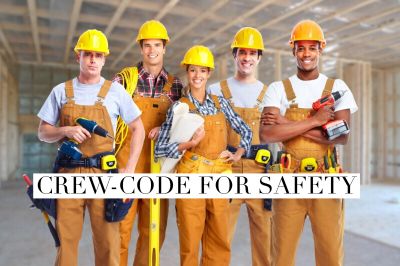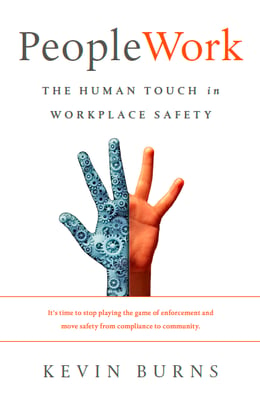To change crew-code in safety will require you to win the hearts and minds of your good people.
 In addition to the Occupational Health and Safety Code, every company has its own corporate safety manual. These are the processes and procedures specific to a company that meet or exceed the minimum standards of the OH&S Code. There’s also an unspoken Crew-Code of “how we do things around here.” This is how workers and supervisors interpret the processes and procedures in the safety manual. The crew-code is powerful, perhaps more so than even the company safety manual. Depending on the crew, in some instances, it’s basically a “what we can get away with” code. Crew-codes that shortchange safety are illegal and dangerous—the opposite of a culture of safety.
In addition to the Occupational Health and Safety Code, every company has its own corporate safety manual. These are the processes and procedures specific to a company that meet or exceed the minimum standards of the OH&S Code. There’s also an unspoken Crew-Code of “how we do things around here.” This is how workers and supervisors interpret the processes and procedures in the safety manual. The crew-code is powerful, perhaps more so than even the company safety manual. Depending on the crew, in some instances, it’s basically a “what we can get away with” code. Crew-codes that shortchange safety are illegal and dangerous—the opposite of a culture of safety.
Crew-code happens at the crew level. That’s good news for safety people and supervisors. You really only have to be able to influence your small crew in order to shift the crew-code. But, the inexperienced supervisor who doesn’t know how to motivate and develop employees, will have a harder time influencing crew-code.
As a front-line supervisor or safety person, here are three ways you can begin to influence the crew-code in safety:
1Crew members naturally want to fit in. Learn this. Know this. Embrace this. This will be the single-most powerful tool in your arsenal. Here’s why. No one ever wants to feel like an outsider on a crew. The pressure to fit in is a driving force that forges group identity. Supervisors have a unique opportunity to influence teamwork through a crew code that raises the bar on safety. A smart supervisor creates a work environment in which crew members will buy into safety as part of an evolving crew code. If they want to fit in and the bar is set high, employees will rise to that bar to be part of the crew. A crew needs to own what they do. Supervisors can influence the crew-code by improving expectations of “how we do things around here.”
2Make the shift from process to people. In a perfect world, processes and procedures are definable and repeatable. But when you throw in the human element, process and procedure don’t always work. People are the most difficult variable to control. It is vital that the human element carries more weight in safety discussions, planning, and protocols. Supervisors and safety people who continue to focus on enforcing rules while ignoring people, will see the crew-code push back. Instead, focus on demonstrating how much you value your people. Focus on making sure they understand how important they are to the company and to you as a front-line supervisor or safety person. People who feel valued, valuable and important will understand the reasons why the processes and procedures are in place. The rules aren’t there to bully them. The rules are there because you value your people and you believe that good people need to be protected.
3Stop viewing employees as replaceable cogs in a machine. Every crew member should be valued as a person first. People know when they aren’t being valued, and it reflects in their work. To value your people, each member of a crew should be appreciated for their unique contribution to the team. A company’s safety standards need to support people at the human level. Certainly any employee can be replaced, but a company should want to keep each staff member healthy and on the job. People don’t like being policed. But people do like being appreciated. As a motivational tool, hitting front-line workers over the head with a rulebook doesn’t work. In fact, it takes much less effort to let them know they’re appreciated. It’s much easier to get employees to buy into a safety program when it’s accompanied by real concern for individuals.
 To change crew-code will require you to win the hearts and minds of your good people. When people feel appreciated and valued, they have reason to feel proud of their work. When they know that their employer is willing to go the extra mile to ensure their safety, they’ll go the extra mile on the job. They will take both their work and safety to heart. It becomes a matter of pride. Make them proud and they’re going to want to protect that pride.
To change crew-code will require you to win the hearts and minds of your good people. When people feel appreciated and valued, they have reason to feel proud of their work. When they know that their employer is willing to go the extra mile to ensure their safety, they’ll go the extra mile on the job. They will take both their work and safety to heart. It becomes a matter of pride. Make them proud and they’re going to want to protect that pride.
People who feel appreciated have the tendency to want to stick around. Turnover and attrition drop in crew cultures of appreciation. Loyalty to the employer rises. When people have loyalty, they have ownership. When you build loyalty, you reduce turnover. And you influence a more positive crew-code for better safety.
Kevin Burns is a management consultant, international thought-leader in workplace safety, and a speaker based in Calgary, Alberta, Canada. Kevin has authored ten books on human performance and safety, including his most recent release, PeopleWork - The Human Touch in Workplace Safety.
©2016 ZeroSpeak Corporation and Kevin Burns.
No part of this post may be reproduced without the expressed consent of the author.


